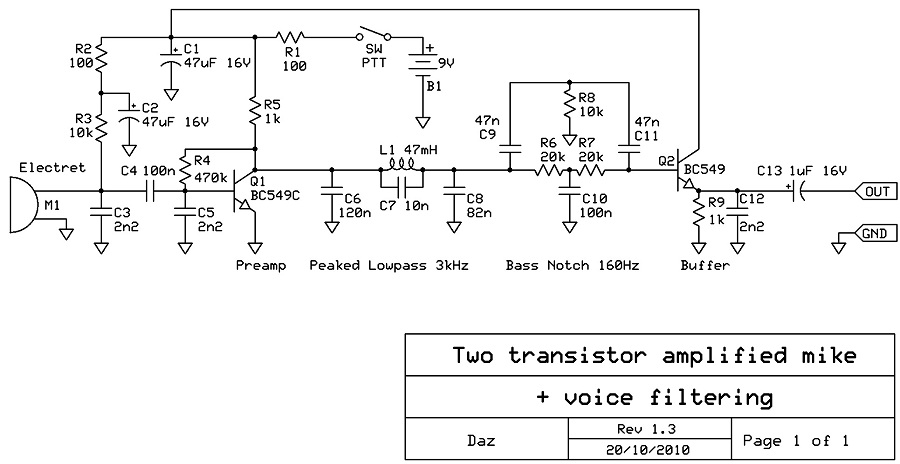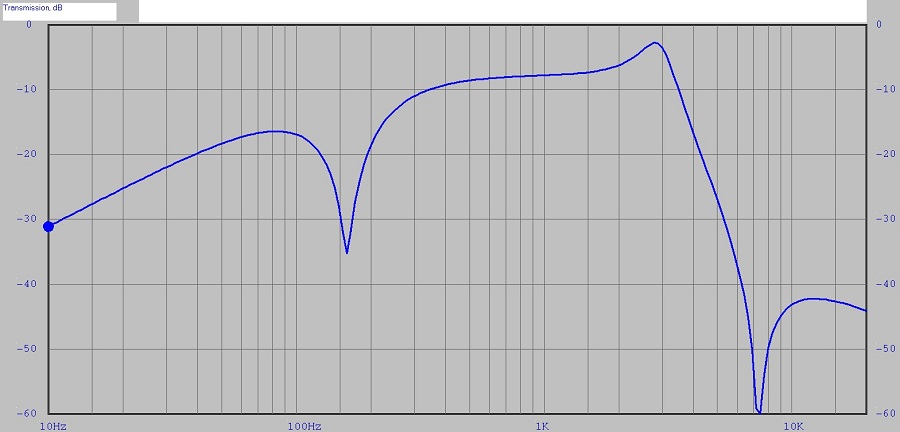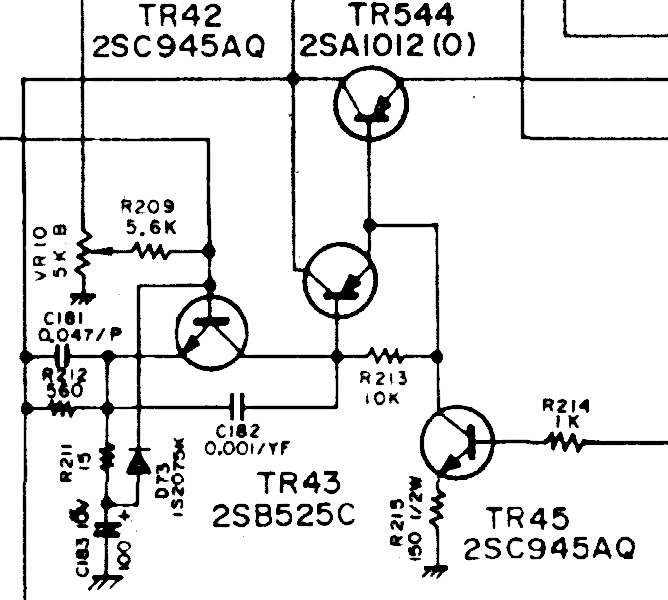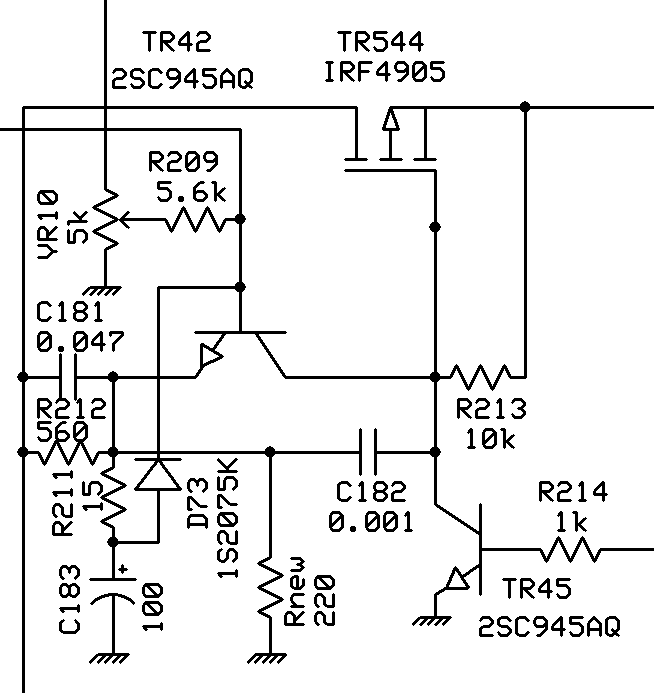

Capacitors
C1
47 uF 16V Electro
C2
47 uF 16V Electro
C3
2n2 Ceramic
C4
47 nF Polyester
C5
2n2 Ceramic
C6
2n2 Ceramic
C7
100n Polyester
Resistors -
all ¼ or ½ watt metal film
R1
100 ohm
R2
100 ohm
R3
10k
R4
470k
R5
1k
Semiconductors
Q1
BC549C
Misc.
SW
Ganged with PTT switch, on during Tx
Electret
2-wire electret microphone insert
Q1 is used
as a typical common-emitter small signal amplifier. Bias is applied via
R4 to keep the transistor biased near the midpoint. R5 is the output collector
load. R1 & C1 filter the supply voltage to reduce turn-on clicks, C2
decouples the supply voltage to the electret mike to prevent feedback via
the supply rail. A BC549C transistor is recommended for low noise, and
high gain. Gain depends on the individual transistor characteristics, and
can be from 15 to 25 dB. Current consumption is around 5 mA.
C3, C5 and C6 decouple the input and output from nearby RF. This prevents RF feedback from occurring. C3 needs to be placed directly at the rear of the microphone element. Connect the mike element using shielded cable to prevent hum pickup.
The coupling capacitors C4 and C7 have values chosen to reduce low frequency content in the audio below 300 Hz. The values can be changed if required, and aren't critical.
There is no
level control in this circuit. Use the transceiver mike gain control instead,
or add a 10k pot at the output terminals, wired as a voltage divider (normal
volume control).

Capacitors
C1
47 uF 16V Electro
C2
47 uF 16V Electro
C3
2n2 Ceramic
C4
100n Polyester
C5
2n2 Ceramic
C6
120n Polyester
C7
10n Polyester
C8
82n Polyester
C9
47n Polyester
C10
100n Polyester
C11
47n Polyester
C12
2n2 Ceramic
C13
1uF 16V Electro
Resistors -
all ¼ or ½ watt metal film
R1
100 ohm
R2
100 ohm
R3
10k
R4
470k
R5
1k
R6
20k
R7
20k
R8
10k
R9
1k
L1 47 mH choke inductor
Semiconductors
Q1
BC549C
Q1
BC549
Misc.
SW
Ganged with PTT switch, on during Tx
Electret
2-wire electret microphone insert
Q1 is used
as a typical common-emitter small signal amplifier. Bias is applied via
R4 to keep the transistor biased near the midpoint. R5 is the output collector
load. R1 & C1 filter the supply voltage to reduce turn-on clicks, C2
decouples the supply voltage to the electret mike to prevent feedback via
the supply rail. A BC549C transistor is recommended for low noise, and
high gain. Gain depends on the individual transistor characteristics, and
can be from 15 to 25 dB. Current consumption is around 9 ma.
C3, C5 and C6 decouple the input and output from nearby RF. This prevents RF feedback from occurring. C3 needs to be placed directly at the rear of the microphone element. Connect the mike element using shielded cable to prevent hum pickup.
The input coupling capacitor C4 reduces low frequency content in the audio below 300 Hz.
There is no level control in this circuit. Use the transceiver mike gain control instead, or add a 10k pot at the output terminals, wired as a voltage divider (normal volume control).
The output filter consists of two stages, a lowpass and a bass notch filter.
Lowpass:
The lowpass
filter serves two purposes: It boosts the high frequency content by more
than 3 dB, and it sharply cuts frequencies over 3 kHz, which can cause
adjacent channel splatter on AM. It is implemented as a type of elliptic
filter, which consists of a lowpass filter with a notch added for a sharper
cutoff.
Bass notch
filter:
The bass notch
filter sharply reduces power-hungry low frequency energy around 100 to
200 Hz, without being overly complex.
* revised 20/10/2010 - Buffer amplifier added to output to make unit insensitive to transceiver input impedance
Frequency response
plot:

For reference: IC1 = NJM2902N = LM324 quad OpAmp equivalent
Part numbering is from
Pearce Simpson Super Cheetah schematic
Verify that this matches
your radio first!
Procedure:
Remove R232 (4M7
squelch hysteresis)
Add 100k resistor from pin
8 to pin 9 on IC1 (linearization)
Add 100n monolithic capacitor
from pin 8 to pin 9 on IC1 (smoothing)
Replace C28 22uF
with 100n monolithic (faster smoothing)
Replace R40 3k3 with
100k (linearization)
Short out R314 (wire
ccw
end of squelch control directly to GND) (squelch control range fix)
Add 47k from pin 9 on
IC1
to pin 7 on IC1 (direct feed from AGC amp)
Optional: (improved muting
response)
Replace TR11 with
a VN10KM MOSFET (better linearity) - form leads to fit: D=C G=B
S=E
Replace R40 3k3 with
470k (better smoothing)
This makes the muting audio
level control more linear.
All resistors Carbon or Metal Film 0.25 or 0.5 watt miniature
This conversion makes
the Squelch control into a linear acting mute. Signals are unmuted proportionally
to their strength, with no delays. This allows weak signals to still be
heard at low volume, and can effectively suppress noise in between words
on SSB.
This modification does
not increase power, it only makes the modulator stage more rugged, and
able to handle higher current demands!
If your radio is working
well already, there is nothing to gain from this mod.
If you have had repeated
2SA1012 failures, or are having trouble finding a genuine 2SA1012, this
mod is for you!
Disconnect the power
to the radio first, as the modulator stage is permanently connected to
the 13.8V line!
Remove 2SA1012 bipolar
transistor - keep all mounting hardware
Replace 2SA1012 with
an IRF4905* or IRF9540 P-channel MOSFET - Carefully clean
off mica washer and heatsink surface, then apply new thermal paste and
mount MOSFET normally & solder in
Remove TR43 (2SB525)
- it is not required
Move R213 (10k) to
connect from MOSFET gate to MOSFET source terminals
Add a wire link from MOSFET
gate to TR42 (2SC945) collector
Replace R215 (150
ohms 1/2W) with a wire link (ie: short it out)
Add a 220 ohm 1/4W resistor
from
TR42 emitter to GND
Power up, and using
a 50 ohm dummy load, readjust AM
POWER for 4 watts average carrier power on AM transmit when unmodulated.
Using a 1kHz sinewave
tone, test that AM modulation reaches close to 100% with no major distortion.
(use a CRO, or check that no adjacent channel splatter is present)
At 4W average AM carrier
power, 100% modulation should be hitting around 16W PEP (typically higher)
Test that close to
13.8V is present on the MOSFET drain terminal in SSB transmit mode
2SA1012 ratings: 5A, 25W,
<0.4V Vsat
IRF9540 ratings: 23A,
130W, on resistance = 0.117 ohms
IRF4905 ratings: 74A,
200W, on resistance = 0.02 ohms *preferred choice
Therefore, a P-Channel power MOSFET should be much more rugged than the 2SA1012, and drop minimal voltage in SSB mode.
Part numbering from Super Cheetah schematic:

TR42 amplifies the audio from the microphone amplifier stages, and drives darlington pair TR43 and TR544. Since both the TR42 and TR43/TR544 stages are common emitter, the signal is amplified and inverted twice. Some negative feedback is applied via R212 back to TR42's emitter. This helps reduce distortion and stabilize the DC operating point (AM carrier power).
C183 is originally a 10V rated part, but is subject to over 12V in SSB mode. It should be replaced with a 16V 100uF electro.
A PNP power transistor
is used for TR544 to pass the heavy current to the final and driver stages
with minimal voltage drop. Low voltage drop is important for maximum peak
power capability. This is the reason behind using the 2SA1012, with it's
very low Vsat voltage of <0.4V.
Modified circuit:
This mod was first
tested with an IRF9540. but an IRF4905 works better due to lower on-resistance

The modified circuit has TR43 removed, and the TR42 collector connected directly to the MOSFET gate.
R215 is replaced with a short, because MOSFETs are voltage controlled, not current controlled. This means in SSB mode TR45 can switch the MOSFET gate to ground, placing almost the full 13.8V across the MOSFET gate/source junction. This is more than enough to turn TR544 fully on for lowest on resistance, thus allowing the RF final and driver stages to get as close as possible to the full 13.8 volt supply.
Rnew is required to pull TR42's emitter closer to ground so the MOSFET can get sufficient gate drive to turn fully on during positive AM modulation peaks. Unfortunately, this makes the DC operating point of the circuit less stable, and the AM power adjustment more critical.
The distortion performance of this circuit may be inferior to the original configuration for two reasons:
The P-channel MOSFET functions as a common source inverting amplifier, so the negative feedback goes via a 100k resistor to the non-inverting OpAmp terminal. The 3k3 resistor scales the negative feedback to set the gain. The negative feedback helps linearize the MOSFET for low distortion. The 1uF capacitor degenerates the total gain at DC to produce a stable operating point (carrier power). Because there is no feedback resistor from the OpAmp inverting terminal to the output terminal, the entire OpAmp open loop gain is available at DC to correct for the MOSFET linearity and temperature drift characteristics.
The 100n ceramic capacitor decouples the supply rail at high frequencies to assist stability. The 680p capacitor produces a dominant pole to help stabilize the negative feedback by reducing the gain at frequencies where the system would otherwise be unstable due to phase shifts caused by MOSFET gate capacitance.

MOSFET final and driver
conversions done properly
IRF540 - Applying correct
bias and thermal bias compensation, tuning